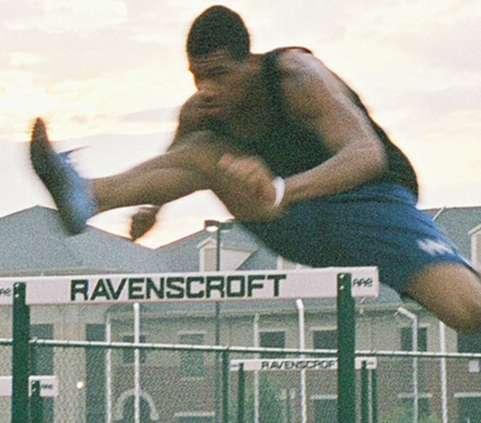One question that a coaching friend of mine brought up in a recent email has to do with whether male high school hurdlers should train over hurdles set at the 42-inch college height. It’s a very good question – one worth addressing in an article. Generally, my answer is that, for a variety of reasons, you have to take each case on an individual basis.
The greatest danger of training over 42’s too soon is that of causing injuries. All of the leg muscles are doing more work over the higher height. The take-off requires more force, the lead leg knee drives higher, there’s a greater impact upon landing, the rotation of the hips requires more effort, and the chest has to come down further over the thigh. All of these motions put strain on the calves, shins, quads, hamstrings, groin, hip flexors, and lower back. Calf and shin injuries in the trail leg can be caused by the added force during take-off; calf and shin injuries in the lead leg can be caused by the impact of landing; hamstring strains in the lead leg can be caused by the further extension needed to clear the hurdle; hamstring strains in the trail leg can be caused by the added force during take-off; groin strains and hip flexor strains in both legs can be caused by the motion of driving the legs up higher than what the athlete is used to.
So, before incorporating any 42-inch hurdle work into a high school hurdler’s training regimen, it’s important to know what that athlete’s body can handle. How flexible is he? How strong is he? How tall is he?
Another consideration is that the take-off distance for the 42’s will be farther away than for the 39’s. Too many reps over the 42’s will cause this farther take-off distance to become habit, which can cause rhythm issues when the athlete goes back to the 39’s. This is a relatively minor problem because any high school hurdler who is ready to try the 42’s is going to be experienced enough where he can adapt quickly and comfortably, but minor mistakes can be major mistakes when they occur in a race. For this reason, I would definitely say that it’s dangerous to work over 42’s during the week of a major meet in which the athlete will be going over 39’s.
The greatest bonus to training over 42’s is that the athlete’s speed and fearlessness will increase when returning to the 39’s. Hurdling over 39-inch barrier will feel like stepping over a rock. It’ll feel like you’re not even hurdling at all, but just lifting your legs a little higher. Because hurdling is so psychologically demanding, creating the illusion that the hurdle is low can be very beneficial. And raising the hurdles to the college height in practice is an excellent way to do that.
Another bonus to training over 42’s is that, assuming the athlete will hurdle in college, he can’t wait until he gets to college before he starts training over 42s; he’ll already be behind his college teammates as soon as he hits campus. He has to at least know what it feels like to clear the higher barriers so that he isn’t shocked to find out how much higher they are at the start of his freshman year.
One mistake I made one day last summer was when I had Johnny Dutch do a full workout over the 42’s. One thing that was problematic was that he was clearing the hurdles too high – not because he was afraid of them, but because he was used to the take-off distance he used for the 39’s; using the same take-off distance for the 42’s forced him to elevate. He still had a very good workout, but the next day he was complaining that the hip of his lead leg was very sore. That was my fault. I had him do too much too soon because I was too eager to see what he could do at the higher height. Even though the injury was minor and didn’t cause him to miss any races, I still was upset with myself for rushing things. Now, as a senior, he’ll occasionally go over 42’s as part of his warm-up, but I don’t have him do anything full-speed at that height. He’s still in high school, and even though his body is growing and maturing, it is still a high-schooler’s body. As the season wears on, we’ll try to incorporate more 42 stuff into his workouts, but only at drill speed. The drills will be enough to prepare him for the college height, and they won’t cause any injuries.

In this photo of Johnny Dutch at a 2006 practice session, it’s clear
that although he’s doing a lot of things right, his clearance of the
42-inch barrier is too high – a direct result of being used to the take-off
distance he uses for the 39-inch high school height.
So, as a coach, you have to use your own discretion. And you really can’t consider the athlete’s input on this one, because the athlete will want to try the 42’s even if his body isn’t ready for them. That’s how competitive athletes are – they want challenges. So the coach has to decide when to start this process, and how rapidly to move forward with it.
© 2007 Steve McGill
